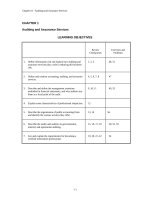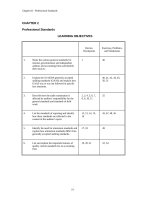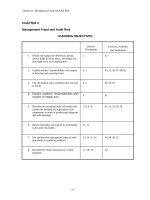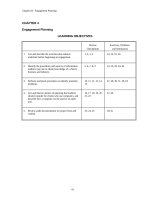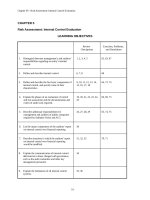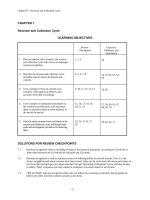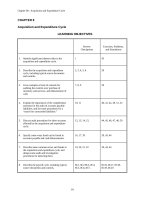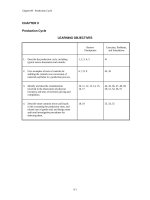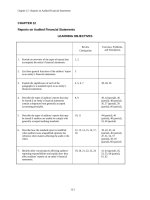Solution manual cost and managerial accounting by barfield 3rd the master budget
Bạn đang xem bản rút gọn của tài liệu. Xem và tải ngay bản đầy đủ của tài liệu tại đây (376.07 KB, 30 trang )
Chapter 13
The Master Budget
Questions
1.
The diversity of resources used, activities conducted, and
quantities of funds provided/used make budgeting important to
business. Since there is no assurance of the continuity of
management, written plans are more useful than spoken plans to
define and communicate the direction of the business. Further,
psychologically, writing plans down is the first step in gaining
commitment to those plans.
2.
The basic budgeting process begins with planning. This planning
involves the setting of objectives and translating those
objectives into required activities and needed resources. The
process also includes a control function of measuring whether the
predetermined objectives have been successfully attained and
providing feedback to concerned and involved parties.
3.
A budget is considered a communication device because it
indicates what is to be accomplished over a certain time period.
It helps to promote unity of goals throughout the organization
because it should have been developed following an exchange of
ideas and information among the people in the organization.
4.
Budgeting translates goals and objectives into the required
resources, activities, and arrangements needed to accomplish
those goals and objectives. The translation is extended to
assign activities and allocate resources to departments and
personnel who are responsible for execution of the budget.
5.
The strategic plan defines the basic purposes and goals of an
organization. As such, the strategic plan identifies the key
variables that will largely determine the success of the
organization. Some of the major factors taken into account in
formulating the strategic plan include the state of the local
and global economy, trends in technology and materials, and
the legislative and political climates.
87
88
Chapter 13
The Master Budget
6.
Longer term plans contain insufficient detail to direct a
business. Although the longer term plans provide general
direction for a business, they are too vague to provide
guidance on a daytoday basis. Consequently, shorter term
plans are compiled to implement the longer term plans for a
specific period. The shorter term plans can be made with
greater attention given to current organizational and
environmental constraints (current market, material and labor
conditions). Also, the roles of specific middle and lower
level managers can be determined in the detailed shortterm
plans.
7.
The budget represents the cornerstone for a company’s
management planning system. Budgeting utilizes goals,
objectives, and forecasts in developing plans for production,
revenues, costs, cash flows, and resource procurement.
Budgeting originates with strategic planning. As goals are
implemented and programs developed, management needs
information about various alternatives so they can be
evaluated. When a specific plan of action is determined, the
budget becomes management’s master plan.
8.
Control is really an extension of planning rather than a
separate managerial function. Without formal planning, there
can be little control.
9.
Budgets serve as planning tools by providing an a priori view
of what is expected to happen in the organization for a
specific period of time. After the period, the budgets serve
as a benchmark against which actual performance can be
compared. Because participants know there will be an after
thefact comparison between the actual performance and the
budget, they are more attentive to the budget in the planning
and implementation phases.
10.
An operating budget presents units expected to be sold or used
by a company and the price/costs associated with those units.
The sales and production budgets are operating budgets.
Financial budgets detail the funds to be generated or
used during the budget period (cash budget and capital
expenditure budget). The results from the operating budgets
are the sources of input for the financial budgets. For
example, sales projected in the sales budget impact the cash
collections/receipts portion of the cash budget.
11.
The master budget is "demand driven" in that it is based in
its entirety on projected sales. In some cases, demand does
not "exist" at the point the budget is prepared (for example,
when the company is introducing a new product). Without sales
or expected sales, the company would have no need to acquire
resources or remain in operation.
Chapter 13
The Master Budget
89
90
Chapter 13
The Master Budget
12.
Managers estimate collections from sales through historical
company data on collection patterns, industry trends/patterns,
and judgment. Current economic information can play an
important part in estimating the collection pattern since
inflation/deflation, interest rates, and employment affect
both business and consumer ability to pay.
Cash collections are important in the budgeting process
because of their impact on the cash budget and the
availability of funds with which to make disbursements for
operating and capital expenditures, and ownership
distributions.
13.
The production and purchases budgets are similar in that they
both begin with a key variable to their particular area, add
ending inventory, and subtract beginning inventory. These
budgets differ in that the key variable for the production
area is sales, but the key variable for purchases is
production. The production budget is used to schedule needed
material, labor, and overhead. The purchases budget is used to
determine the amount and timing of material input to the
production process as well as provide input into the cash
budget as to the amount and timing of cash disbursements for
such purchases.
14.
To predict overhead cost for a specific volume of production,
costs must be separated into those that are volume dependent
(variable costs), and those that are volume independent (fixed
costs). The expected overhead for a given period is the sum
of the projected fixed cost plus the total variable cost. The
total variable cost is a function of the variable cost per
unit and the expected volume of production.
15.
Cash is a very important resource for an organization because
it is the medium of exchange for organizational inputs and
outputs. A shortage of cash creates liquidity problems and may
prevent the firm from acquiring inputs that are crucial to its
survival. A firm can cover periods of cash shortages with
loans, equity sales, or sales of assets.
16.
A company needs to maintain a minimum cash balance simply to
have funds on hand in the event of an emergency or in the
event that the budget does not "work out" exactly as planned.
If cash collections are lower or cash disbursements are higher
than expected, the minimum cash balance provides a cushion or
margin of safety to fall back on. It is also possible that the
company’s bank requires a minimum cash balance in the
corporate account as either a condition of the account or as a
compensating balance for an outstanding loan.
Chapter 13
The Master Budget
91
17.
Future sales are the primary source for future cash
collections. Consequently, the firm's future sales and its
collections policy, which is reflected in its current and
projected accounts receivable balance, are the primary
determinants of the amounts and timing of future cash
collections.
18.
Pro forma financial statements give managers a preview of how
things will turn out if actual activities conform to budgeted
activities. If managers are not pleased with what is
revealed, they are in a position to adjust their plans and
actions.
19.
The pro forma financial statements serve two primary purposes;
they are useful summary performance measures of the operating
plans and they may highlight organizational constraints that
cannot be identified in the other budgets. For example,
contracts with creditors may require the company to maintain a
certain interest coverage ratio or a particular debttoasset
ratio. Only the pro forma income statement and balance sheet
would provide confidence that the firm would be in compliance
with these contractual requirements.
20.
They are similar in that they both focus on the balance of
cash and explain the change in cash balance over a period of
time. However, there are substantial differences between the
two. For example, the cash budget typically covers shorter
time periods and has as its primary objective the
identification of periods of cash shortages and cash excesses.
The statement of cash flows has as its primary purpose the
identification of the activities (operating, investing, and
financing) that explain the change in the cash balance for a
period.
21.
The process of continuous budgeting provides an on going 12
month period of planning for managers. The planning horizon
does not change and keeps management aware of the need for
foresight and the ramifications of their activities.
22.
Budgetary slack results from an overestimation of expected
expenses or an underestimation of expected revenues so that
the budget will be more easily achieved. Because managerial
performance is evaluated based on a comparison of actual and
budgeted performance, the actual performance will appear to be
more favorable if sufficient slack is impounded in the budget.
92
Chapter 13
The Master Budget
23.
Employees are more likely to attempt to achieve objectives
that they had a part in setting than ones that were imposed on
them. Participation also substantially increases the
acceptance of budget requirements, such as monetary or other
resource constraints. Empirical literature has shown that
there is a high degree of correspondence between the
participatory budgeting process and job satisfaction. Finally,
helping in the budgeting process may result in a higher degree
of commitment to the organization (not just its goals).
24.
Sections of budget manual
a. Statement of purposes and
desired results
b. Budgetary activities to
be performed
c. Calendar of budgetary
activities
d. Sample forms
e. Original, revised and
approved budgets
25.
The budget manual provides for standards of performance and
quality control in the budgeting process. Having and using a
budget manual communicates top management’s commitment to an
effective budgeting process for lowerlevel managers.
26.
Students will have different answers. No solution provided.
Reasons for the section
a. To communicate as a first
step of cooperation
b. To designate who is
responsible
c. To indicate time table and
provide coordination of
efforts
d. To provide for consistent
preparation
e. To reflect revision of the
process and serve as a
control document
Exercises
27.
January February March
Budgeted sales 12,800 12,000 16,000
Ending inventory 6,000 8,000 9,600
Total required 18,800 20,000 25,600
Beginning inventory (6,400) (6,000) (8,000)
Budgeted production 12,400 14,000 17,600
28.
Quarter Total
1st 2nd 3rd 4th
Sales 270,000 340,000 245,000 275,000 1,130,000
End. inv. 102,000 73,500 82,500 90,000 90,000
Total 372,000 413,500 327,500 365,000 1,220,000
Beg. inv. ( 81,000) (102,000) ( 73,500) ( 82,500) (81,000)
Production 291,000 311,500 254,000 282,500 1,139,000
Chapter 13
The Master Budget
29.
93
Sales of boots 21,480
EI of boots 3,800
Total 25,280
BI of boots (1,154)
Production 24,126
24,126 × 2.5 ft. = 60,315 ft.
60,315 ft. ÷ 3 ft. per yard = 20,105 yds.
Yds. needed for production 20,105
Ending inventory 9,000
Total 29,105
Beginning inventory (3,000)
Yds. to purchase 26,105
30.
a., b. Sales (units)
190,000
EI 20,000
Total 210,000
BI (24,500)
Production 185,500
Concrete
Gravel
(12 lbs. per) (15 lbs. per)
Production
2,226,000 2,782,500
EI
68,600 92,500
Total
2,294,600 2,875,000
BI
(82,000) (65,300)
Purchase (lbs) 2,212,600 2,809,700
Cost per lb.
×0.10 ×0.03
Cost
$ 221,260 $ 84,291
31. a.
b.
Boxes Trays
Production budget
Units of sales 42,000 24,000
Units desired in ending inv. 3,500 2,000
Units needed 45,500 26,000
Units in beginning inv. (1,000) (500)
Budgeted production 44,500 25,500
Purchases budget Material A Total
Units needed for production
(42,500 2) + (25,500 1) 114,500
Required ending inventory (annual units ÷ 12) 9,542
Total requirements 124,042
Less beginning inventory (4,000)
Pounds to be purchased 120,042
94
Chapter 13
The Master Budget
Purchases budget Material B
Units needed for production
(44,500 4) + (25,500 4) 280,000
Required ending inventory (annual units ÷ 12) 23,333
Total requirements 303,333
Less beginning inventory (6,000)
Pounds to be purchased 297,333
c.
Direct labor budget
Required hours 89,000* 51,000** 140,000
*
44,500 2 = 89,000; **25,500 2 = 51,000
Overhead budget
Activity base (hours) 89,000 51,000
Multiply by rate × $2 × $2
Overhead cost $178,000 $102,000 $280,000
a. January February March
Nov. sales (30% × $41,500) $12,450
Dec. sales (30% × $38,000) 11,400
Dec. sales (30% × $38,000) $11,400
Jan. sales (40% × $29,500 × 99%)
11,682
Jan. sales (30% × $29,500) 8,850
Jan. sales (30% × $29,500) $ 8,850
Feb. sales (40% × $34,000 × 99%) 13,464
Feb. sales (30% × $34,000) 10,200
Mar. sales (40% × $39,500 × 99%) 15,642
Total collections $35,532 $33,714 $34,692
d.
32.
b.
Feb. sales to be collected in April (30% × $34,000) $10,200
Mar. sales to be collected in April (30% × $39,500) 11,850
Mar sales to be collected in May (30% × $39,500) 11,850
Total A/R balance at March 31 $33,900
33.
a.
$606,900 Balance at Oct. 1
(450,000) Remainder of Sept. billings
$156,900 Remainder of Aug. billings
$156,900 = 0.25 August billings
$627,600 = August billings
b.
$450,000 = 0.80 September billings
$562,500 = September billings
$562,500 × 3% = $16,875 estimated uncollectibles
95
Chapter 13
The Master Budget
c.
Oct. collections of Aug.
billings ($627,600 × 22%)
Oct. collections of Sept.
billings ($562,500 × 55%)
Oct. collections of Oct.
billings ($800,000 × 20%)
Total October collections
34.
309,375
160,000
$607,447
a.
$171,000 Balance at May 31
(135,000) Remainder of May sales
$ 36,000 Remainder of April sales
$36,000 = 0.15 April credit sales
$240,000 = April sales on credit = 0.75 of total sales
$320,000 = Total April sales
b.
$135,000 = 0.40 May sales
$337,500 = May sales on credit
c.
June collections of April sales
June collections of May sales
($337,500 × 25%)
June cash sales ($650,000 × 25%)
June collections of June credit sales
($650,000 × 75% × 60%)
Total June collections
d.
35.
$138,072
$ 36,000
84,375
162,500
292,500
$575,375
Balance from May sales ($337,500 × 15%) $ 50,625
Balance from June sales ($487,500 × 40%) 195,000
Total June 30 A/R balance
$245,625
Income after taxes
Accr. income tax expense (no cash involved)
Increase in A/R (collected less than sold)
Decrease in A/P (paid for more than purch.)
Depreciation (no cash involved)
Estimated bad debts (no cash involved)
Projected increase in cash
$280,000
62,000
(41,000)
(18,300)
71,200
13,100
$367,000
Note: The declaration of a dividend does not affect cash, nor
does it affect net income for the period.
36. CGS [$2,000,000 × (1.00 0.40)=$2,000,000 × 0.6] $1,200,000
Less decr. in inventory (sold more than bought) (33,750)
Plus decr. in A/P (paid for more than bought) 40,000
Cash payments for inventory $1,206,250
Wages expense 512,500
Other cash expenses 235,250
Total cash disbursements $1,954,000
96
Chapter 13
The Master Budget
37. July August September Total
Beginning cash balance
$ 4,500 $ 2,900 $ 2,900 $ 4,500
Cash receipts
8,200 10,100 16,600 34,900
Total cash available
$12,700 $13,000 $19,500 $39,400
Cash disbursements:
Payments on account
$ 1,300 $ 3,900 $ 5,700 $10,900
Wage expenses 5,000 6,100 6,100 17,200
Overhead costs
4,000 4,600 4,400 13,000
Total disbursements $10,300 $14,600 $16,200 $41,100
Cash excess (inadequacy) $ 2,400 $(1,600) $ 3,300 (1,700)
Minimum cash balance
(2,500) (2,500) (2,500) (2,500)
Cash available (needed) $ (100) $(4,100) $ 800 $(4,200)
Financing:
Borrowings (repayments) $ 500 $ 4,500 $ (500) $ 4,500
Acquire (sell) investments 0 0
Receive (pay) interest (50) (50)
Ending cash balance $ 2,900 $ 2,900 $ 2,750 $ 2,750
38. a.
Dinners Desserts Total
Sales $800,000 $1,200,000 $2,000,000
Variable costs (560,000) (960,000) (1,520,000)
Contribution margin $240,000 $ 240,000 $ 480,000
Fixed costs (30,000)
Net income $ 450,000
b.
CGS = $4,000,000 + (0.40 × $20,000,000) = $12,000,000
c.
CGS = [(1 0.25) × $800,000] $600,000
Increase in inventories 60,000
Decrease in A/P 24,000
Total cash payment for inventories $684,000
d.
Sales (200,000 × 1.10) × ($20 × 1.15) = $5,060,000
Variable costs (200,000 × 1.10) × $6 = (1,320,000)
Contribution margin $3,740,000
Fixed costs ($600,000 + $200,000) (800,000)
Net operating income $2,940,000
(CPA adapted)
97
Chapter 13
The Master Budget
39.
Sales* $467,241
Cost of Goods Sold
Material (45,000 × $4.40) $198,000
Labor (45,000 × $2.20) 99,000
Overhead ($99,000 × 0.50) 49,500 346,500
Gross profit $120,741
Expenses
Selling** [$10,000 + ($0.08 × Sales)] $ 47,379
Administrative 50,000 97,379
Net income before taxes $ 23,362
Sales $$346,500 $10,000 $50,000 0.08(Sales)
= 0.05(Sales)
0.87(Sales) = $406,500
Sales = $467,241
**
Selling expenses = $10,000 + (0.08 × $467,241)
Selling expenses = $47,379
Sales Price = $467,241 45,000 = $10.38 rounded
*
40.
a.
Beginning balance $ 500,000
July credit sales 600,000
Cash collections in July (440,000)
Writeoffs in July (32,000)
Ending balance $ 628,000
b.
Cash collections, $440,000
c.
Credit sales, $600,000, and the provision for
uncollectible accounts, $24,000.
(CPA adapted)
41.
Fredrik Novelty Wholesale Store
Pro Forma Income Statement
For the Month Ended May 31, 2003
Sales
Cost of goods sold ($300,000 1.5)
Gross margin
Selling and administrative expenses
Depreciation expense
Bad debts expense ($300,000 × 3%)
Net income
42.
$300,000
(200,000)
$100,000
$40,000
5,000
9,000
54,000
$ 46,000
(CPA adapted)
a.
Original variable cost = $25 × 0.75 = $18.75;
variable cost after purchase of new machine: $18.75 × (1
0.35) = $12.19 (rounded).
b.
$400,000 + $350,000 = $750,000
98
Chapter 13
The Master Budget
c.
120,000 × ($25 $12.19) $750,000 = $787,200
d.
Profit with new machine
$787,200
Original profit:
120,000 × ($25 $18.75) $400,000 = 350,000
Profit improvement with new machine $437,200
Assuming all costs related to the machine have been
considered in the analysis, Joan should acquire the
equipment.
Problems
43.
Production Budget 2003
Jan.June JulyDec. Total
Sales budget 380,000 420,000 800,000
Ending inventory 76,000 90,000 90,000
Beginning inventory (30,000) (76,000) (30,000)
Production 426,000 434,000 860,000
Material A Purchases Budget 2003
Jan.June JulyDec. Total
Production budget 2,130,000 2,170,000 4,300,000
Ending inventory 250,000 300,000 300,000
Beginning inventory (200,000) (250,000) (200,000)
Purchases 2,180,000 2,220,000 4,400,000
Material B Purchases Budget 2003
Jan.June JulyDec. Total
Production budget 1,278,000 1,302,000 2,580,000
Ending inventory 160,000 200,000 200,000
Beginning inventory (140,000) (160,000) (140,000)
Purchases 1,298,000 1,342,000 2,640,000
44.
a.
Sales budget
Ending inventory (375,000 × 0.03)
Beginning inventory
Production Budget
300,000
11,250
(4,300)
306,950 cans
b.
Tea Purchases Budget (pounds)
Production budget (306,950 × (14 ÷ 16)) 268,581.25
Ending inventory (11,250 × (14 ÷ 16)) 9,843.75
Beginning inventory (2,750.00)
Purchases 275,675.00
c.
Sugar Purchases Budget (pounds)
Production budget (306,950 × (2 ÷ 16)) 38,368.75
Ending inventory (11,250 × (2 ÷ 16)) 1,406.25
Beginning inventory (600.00)
Purchases 39,175.00
Chapter 13
The Master Budget
99
d.
($4.50 × 275,675) + ($0.30 × 39,175) = $1,252,290
45.
e.
($1,252,290 × 0.30) × 0.98 = $368,173.26
a.
January February March Total
Sales
3,200 2,600 3,700 9,500
Ending inventory 650 925 900 900
Beginning inventory (800) (650) (925) (800)
Production 3,050 2,875 3,675 9,600
b. (Felt) January February March Total
Production (yds.) 2,287.50 2,156.25 2,756.25 7,200.00
End. inv. 431.25 551.25 540.00 540.00
Beg. inv. (457.50) (431.25) (551.25) (457.50)
Purchases 2,261.25 2,276.25 2,745.00 7,282.50
Cost per yd. × $7.00 × $7.00 × $7.00 × $7.00
$ of purchases $15,828.75 $15,933.75 $19,215.00 $50,977.50
(Ribbon)
January February March Total
Production (in.) 61,000.00 57,500.00 73,500.00 192,000.00
End. Inv. 11,500.00 14,700.00 14,400.00 14,400.00
Beg. Inv. (12,200.00) (11,500.00)(14,700.00) (12,200.00)
Purchases 60,300.00 60,700.00 73,200.00 194,200.00
Cost per yd. × $0.05 × $0.05 × $0.05 × $0.05
$ of purchases $ 3,015.00 $ 3,035.00 $ 3,660.00 $ 9,710.00
Total purchases $18,843.75 $18,968.75 $22,875.00 $60,687.50
100
c.
Chapter 13
The Master Budget
Month of Payment
January February March Total
Month of purchase:
December $ 3,800.00 $ 3,800.00
January 14,773.50 $ 3,768.75 18,542.25
February 14,871.50 $ 3,793.75 18,665.25
March 17,934.00 17,934.00
Totals $18,573.50 $18,640.25 $21,727.75 $58,941.50
d. January February March Total
Factory overhead:
$5,200 + $2.25(prod.)$12,062.50 $11,668.75 $13,468.75 $37,200.00
Nonfactory overhead:
$2,800 + 10%(rev.) 8.560.00 7,480.00 9,460.00 25,500.00
Totals $20,662.50 $19,148.75 $22,928.75 $62,700.00
e.
January February March Total
Beg. Balance
$18,760.00 $12,494.00 $13,000.00 $ 18,760.00
Collections
58,080.00 48,960.00 62,640.00 169,680.00
Cash available
$76,840.00 $61,454.00 $75,640.00 $188,440.00
Cash needed:
Purchases $18,573.50 $18,640.25 $21,727.75 $ 58,941.50
Overhead
20,622.50 19,148.75 22,928.75 62,700.00
DL ($3/hat)
9,150.00 8,625.00 11,025.00 28,800.00
Taxes
5,000.00 0.00 0.00 5,000.00
Bonuses
15,000.00 0.00 0.00 15,000.00
Total
$68,346.00 $46,414.00 $55,681.50 $170,441.50
Cash excess $ 8,494.00 $15,040.00 $19,958.50 $ 17,998.50
Min. Balance
12,000.00 12,000.00 12,000.00 12,000.00
Cash (needed) avail. $(3,506.00) $ 3,040.00 $ 7,958.50 $ 5,998.00
Financing:
Borrow (repay) 4,000.00 (2,000.00) (2,000.00) 0.00
Receive (pay) interest 0.00 (40.00) (60.00) (100.00)
Ending cash balance $12,494.00 $13,000.00 $17,898.50 $17,898.50
46.
a.
(72,000* × 0.48) + ($120,000 × 0.50) = $94,560
*January sales: ($34,560 + $1,440) ÷ 0.50 = $72,000
b.
Beginning inventory $ 52,400
Purchases ($120,000 × 0.75 × 0.55)
+($130,000 × 0.75 × 0.45) 93,375
Cost of Goods Sold ($120,000 × 0.75) (90,000)
Ending inventory $ 55,775
c.
First, determine expected earnings for February:
Sales $120,000
CGS (90,000)
Gross margin $ 30,000
Operating expenses (25,500)
Net income $ 4,500
Chapter 13
The Master Budget
101
Retained earnings, beginning balance $(14,000)
Earnings 4,500
Ending balance $( 9,500)
d.
Beginning balance $ 12,000
Cash collections 94,560
Cash available $106,560
Cash disbursements:
Accounts Payable $70,200
Other 21,500 91,700
Cash excess $ 14,860
Since there is a cash excess of $14,860, ($14,860
$8,000) = $6,860 is available for investment.
47.
a.
Billed
6/10
6/20
7/10
7/20
6/10
6/20
7/10
7/20
b.
7/10
7/20
7/20
7/30
Collected
$600,000 × 0.5 × 0.5 × 0.18
$800,000 × 0.5 × 0.5 × 0.18
$800,000 × 0.5 × 0.5 × 0.80 × 0.98
$700,000 × 0.5 × 0.5 × 0.80 × 0.98
$ 27,000
36,000
156,800
137,200
$357,000
Billed
8/20
9/10
Collected
9/20 $800,000 × 0.50 × 0.50 × 0.18
9/20 $800,000 × 0.50 × 0.50 × 0.80 × 0.98
8/20
9/10
$ 36,000
156,800
$192,800
c.
($600,000 × 0.70) × 0.25 = $105,000
d.
($800,000 × 0.70 × 0.75) + ($700,000 × 0.70 × 0.25) =
$542,500
e.
July purchases:
($700,000 × 0.70 × 0.75) + ($800,000 × 0.70 × 0.25) =
$507,500
August purchases:
($800,000 X 0.70 × 0.75) + ($600,000 × 0.70 × 0.25) =
$525,000
August payments:
($507,500 + $525,000) × 0.50 = $516,250
102
Chapter 13
The Master Budget
(CMA adapted)
48.
Freeman Manufacturing
Cash Budget
For Years Ending March 31, 2002 and 2003
2002 2003
Beginning cash bal. $ 0 $ 75,000
CollectionsSchedule A
$ 825,000 $1,065,000
Disbursements:
Direct Material
Schedule B $ 220,000 $ 245,000
Direct Labor 300,000 360,000
Variable overhead 100,000 120,000
Fixed costs 130,000 130,000
Total $(750,000) $(855,000)
Excess cash collections
over disbursements 75,000 210,000
Cash available $ 75,000 $ 285,000
Cash received from sale
of A/R & inventories 90,000 (2) 0
Total cash available $ 165,000 $285,000
Payments to creditors (90,000) (2) (270,000)
Ending cash balance (1) $ 75,000 $ 15,000
(1) This amount could have been used to pay general creditors
or carried forward to the beginning of next year.
(2) ($600,000 × 60%) ($50,000 + $40,000)
Schedule A (Collections from Customers):
2002
2003
Sales $900,000
$1,080,000
Beg. accounts receivable 0 75,000
Total $900,000 $1,155,000
Ending accounts receivable (75,000) (90,000)
Collections $825,000 $1,065,000
Schedule B (Disbursements for Direct Material):
2002
2003
Direct material req'd for prod. $200,000 $240,000
Required ending inventory (3) 40,000 (4) 50,000
Total needed $240,000 $290,000
Beginning inventory 0 20,000
Total materials purchased $240,000 $270,000
Ending accounts payable (20,000) (25,000)
Disbursements $220,000 $245,000
(3) 12,000 units × 2/12 = 2,000; 2,000 × $20 per unit = $40,000
(4) 15,000 units × 2/12 = 2,500; 2,500 × $20 per unit = $50,000
(CMA adapted)
Chapter 13
The Master Budget
103
104
49.
Chapter 13
The Master Budget
a.
$960,000 ÷ 0.60 = $1,600,000
b.
($1,600,000 × 0.70) ($960,000 $60,000) = $220,000
c.
1 0.70 = 0.30
d.
Total expenses = 85% of sales;
Total variable costs = 70% of sales;
Fixed costs = (0.85 0.70) × $1,600,000 = $240,000
e.
Cash receipts: $1,600,000 × 0.45 = $ 720,000
Total expenses: $1,600,000 × 0.85 = $1,360,000
Depreciation
30,000
Cash expenses
$1,330,000
Cash disbursement: $1,330,000 × 0.55 = $ 731,500
50.
51.
a.
Fixed production cost: ($2,000,000 × 1.08) × 0.80 = $1,728,000
Variable production cost: $40 × 1.15 = $46
Cost per unit: ($1,728,000 ÷ 200,000) + $46 = $54.64
b.
Price = $54.64 + (0.25 × $54.64) = $68.30
c.
Sales ($68.30 × 200,000) $13,660,000
CGS ($54.64 × 200,000) (10,928,000)
Gross margin $ 2,732,000
Selling and administration
($2,000,000 × 1.08) $1,728,000 (432,000)
Income before taxes $ 2,300,000
d.
Let Y = the sales price per unit that yields income
before taxes = 25 percent of sales, then:
200,000Y $10,928,000 $432,000 = 0.25(200,000Y)
150,000Y = $11,360,000
Y = $75.73 (rounded)
a.
Sales Budget:
Mixers: $ 50 × 60,000 = $3,000,000
Doughmakers: 120 × 40,000 = 4,800,000
Total budgeted sales $7,800,000
b.
Mixers Doughmakers
Budgeted sales 60,000 40,000
Ending inventory 20,000 5,000
Beginning inventory (15,000) (4,000)
Budgeted production 65,000 41,000
Chapter 13
The Master Budget
105
c.
Purchasing Budgets:
Motors Beaters Fuses
Mixer production 65,000 130,000 130,000
Doughmaker production 41,000 164,000 123,000
Ending inventory 3,600 24,000 7,500
Beginning inventory (2,000) (21,000) (6,000)
To be purchased 107,600 297,000 254,500
d.
Purchasing Budget in Dollars:
Motors Beaters Fuses
To be purchased 107,600 297,000 254,500
× price per unit × $15 × $1.25 × $2
Budgeted purchases $1,614,000 $371,250 $509,000
e.
Direct Labor Budget:
Mixers: $7 × 2 × 65,000 $ 910,000
Doughmakers: $9 × 3 × 41,000 1,107,000
Budgeted labor cost $2,017,000
(CPA adapted)
52.
Note: The following solution was prepared in a spreadsheet.
Although all numbers are rounded to the nearest dollar in the
budgets shown, all underlying calculations were based on
precise numbers.
Sales Budget:
Jan.
Feb.
March
April
8,000 10,000 15,000 12,000
× $12 × $12 × $12 × $12
$96,000 $120,000 $180,000 $144,000
Accounts Receivable collections (70%, 20%, 10%):
January
February March Total
November $ 7,000 $ 0 $ 0 $ 7,000
December 13,000 6,500 19,500
January 67,200 19,200 9,600 96,000
February 0 84,000 24,000 108,000
March 0 0 126,000 126,000
Total $87,200 $109,700 $159,600 $356,500
Accts. Rec. ending balance = $26,500 + $396,000 $356,500
= $66,000
Production Budget:
January February March Total April
Sales 8,000 10,000 15,000 33,000 12,000
Ending inv. 500 750 600 600 550
Beginning inv. (400) (500) (750) (400) (600)
Production 8,100 10,250 14,850 33,200 11,950
106
Chapter 13
The Master Budget
Purchases Budget:
Quarter
January February March Total April
Production 8,100 10,250 14,850 33,200 11,950
Gallons × 1.2 × 1.2 × 1.2 × 1.2 × 1.2
Production needs 9,720 12,300 17,820 39,840 14,340
Ending inv. 615 891 717 717
Beginning inv. (1,000) (615) (891) (1,000)
Purchases 9,335 12,576 17,646 39,557
January February March Total
Purchases 9,335 12,576 17,646 39,557
Cost per gallon ×$0.80 ×$0.80 ×$0.80 ×$0.80
Cost $7,468 $10,061 $14,117 $31,646
Payment of Accounts Payable (60%, 40%):
December
January
February
March
Total
January February March Total
$2,148 $ 2,148
4,481 $2,987 7,468
6,036 $ 4,024 10,060
8,470 8,470
$6,629 $9,024 $12,494 $28,146
A/P ending balance = $2,148 + $31,646 $28,147
= $5,647
Direct Labor Budget:
January February March Total
Production 8,100 10,250 14,850 33,200
DLH per unit × 0.5 × 0.5 × 0.5 × 0.5
Total DLHs 4,050 5,125 7,425 16,600
DL rate × $6 × $6 × $6 × $6
DL cost $24,300 $30,750 $44,550 $99,600
Variable OH Budget:
January February March Total
Production 8,100 10,250 14,850 33,200
MH per unit × 5 × 5 × 5 × 5
Total MHs 40,500 51,250 74,250 166,000
VOH rate × $0.06 × $0.06 × $0.06 × $0.06
VOH cost $ 2,430 $ 3,075 $ 4,455 $ 9,960
Fixed OH Budget
January February March Total Comments
Salaries $ 6,500 $ 6,500 $ 6,500 $19,500 (cash)
Utilities 1,000 1,000 1,000 3,000 (cash)
Insurance 200 200 200 600 (decr.in
prep.ins.)
Depreciation 2,300 2,300 2,550 7,150 (incr. in
acc.depr.)
Chapter 13
The Master Budget
107
FOH cost $10,000 $10,000 $10,250 $30,250
Other Payments, Collections, and Cost Adjustments:
January February March Total Comments
Dividends $10,000 $10,000 (cash)
Equipment $ 7,200 7,200 (cash;incr.
in equip.)
Add'l depr. 250 250 (incr. in
depr.exp.&
acc. dep.)
Int. expense $ 250 $ 146 $ 396 (cash)
Int.received 140 140 (cash)
S&A costs 25,800 25,800 25,800 77,400 (cash)
SopChoppy
Cash Budget
For the First Quarter of 2003
January February March Total
Beg. bal. $ 5,080 $ 5,071 $ 5,076 $ 5,080
Collections 87,200 109,700 159,600 356,500
Cash available $ 92,280 $114,771 $164,676 $361,580
Disbursements:
Purchases $ 6,629 $ 9,024 $ 12,494 $ 28,147
DL 24,300 30,750 44,550 99,600
VOH 2,430 3,075 4,455 9,960
FOH 7,500 7,500 7,500 22,500
S&A 25,800 25,800 25,800 77,400
Equip. 7,200 7,200
Total $ 66,659 $ 76,149 $101,999 $244,807
Cash excess $ 25,621 $ 38,623 $ 62,677 $116,773
Min. bal. (5,000) (5,000) (5,000) (5,000)
Cash avail. $ 20,621 $ 33,623 $ 57,677 $111,773
Financing:
Repay $(10,300) $(14,700) $ (25,000)
Investment 0 (18,700) $(57,800) (76,500)
Pay div. (10,000) (10,000)
Receive (pay) 140 140
interest (250) (147) (397)
Total $(20,550) $(33,547) $(57,660) $(111,757)
Ending balance $ 5,071 $ 5,076 $ 5,017 $ 5,016
108
Chapter 13
The Master Budget
SopChoppy
Budgeted Income Statement
For the First Quarter of 2003
Sales
Cost of Goods Sold
Beginning inventory FG
Cost of goods manufactured
Cost of goods avail. for sale
Ending inv. FG (600 × $5.26)
Gross margin
Selling & administrative expenses
Operating income
Other income and expenses
Interest expense
Interest revenue
Net income
$ 2,104
171,682
$173,786
3,156
$ (397)
140
$396,000
170,630
$225,370
77,400
$147,970
(257)
$147,713
SopChoppy
Budgeted Schedule of Cost of Goods Manufactured
For the First Quarter of 2003
Beginning work in process
Raw material used:
Beginning raw materials
$ 800
Purchases
31,646
Available for use
$32,446
Ending inventory (717 × $.80)
574
Cost of raw materials used
$31,872
Direct labor
99,600
Variable factory overhead
9,960
Fixed factory overhead
30,250
Total mfg. costs in process
Ending work in process
Cost of goods manufactured
$ 0
171,682
$171,682
(0)
$171,682
109
Chapter 13
The Master Budget
SopChoppy
Budgeted Balance Sheet
March 31, 2003
Assets
Cash
Accounts receivable
Raw material inventory
Finished goods inventory
Prepaid insurance
Investments
Building and machinery
Accumulated depreciation
Total Assets
$ 5,016
66,000
574
3,156
600
76,500
$309,000
(27,150)
281,850
$ 433,696
Liabilities and Stockholders’ Equity
Liabilities:
Accounts payable
$ 5,647
Note payable equipment
1,800
$ 7,447
Stockholders' Equity:
Common stock
$100,000
Paidin capital
50,000
Retained earnings
276,249
426,249
Total Liabilities &
Stockholders' Equity
$433,696
Cases
53.
a.
Let Y = the level of gross billings that meets the
required return objective, then:
Y $425,000 0.20Y = $700,000 + $240,780
0.80Y = 1,365,780
Y = $1,707,225
Budget:
Gross billings
Variable expenses
Overhead $256,083.75
Client service 85,361.25
Contribution margin
Fixed costs
Salaries
$300,000.00
Overhead
125,000.00
Net operating earnings
$1,707,225
(341,445)
$1,365,780
(425,000)
$ 940,780
110
Chapter 13
The Master Budget
b.
54.
A number of actions are possible depending largely on the
operating climate of the firm. Many of the actions that
could be taken can fit within one of the three groupings
that follow.
1.
Increase the staffing level. A larger staff is a
reasonable alternative only if there is an
expectation that billings can be increased well
above the budgeted level if the firm were allowed to
grow.
2.
Reduce the budgeted billings level and try to
maintain the budgeted level of earnings by cutting
costs. In selecting activities to cut, the firm
would try to identify those activities that are not
value adding.
3.
Try to selectively cut down the size of the business
by dropping those clients that contribute the least
to the bottom line. This action requires the firm
to have knowledge about the relative profitability
of the various services it offers and the relative
amounts of profits generated by various classes of
clients (large, small, industry group, tax service,
audit, etc.).
a., b. (Supporting calculations for these requirements are
keyed to the amounts and follow the cash budgets.)
CME, INC.
Cash Budgets
(Dollars in thousands)
For Year Ending
For Month Ending
December 31, 2002
January 31, 2002
Cash balance,Jan.1
$ 750
$ 750
Cash receipts:
Program revenue
12,000
1,440 (3)
Membership income
10,000 (1)
0
Total cash available
$22,750
$2,190
Cash outflows:
Seminar
Instruction fees $ 8,400(2)
$ 0
Facilities
5,600
672 (4)
Promotion
1,000
100 (5)
Total
$15,000
$ 772
Salaries
960
80 (6)
Benefits, staff
240
18 (7)
Office lease
240
20 (8)
Gen. admin.
1,500
125
Gen. promotion
600
50 (9)
Research grants
3,000
500
Cap. expenditures 510
102 (10)
Total
(22,050)
(1,667)
111
Chapter 13
The Master Budget
Ending cash balance
$ 700
Supporting calculations:
(1) 100,000 members × $100 = $10,000,000
(2) $12,000,000 × 70% = $8,400,000
(3) $12,000,000 × 12% = $1,440,000
(4) $5,600,000 × 12% = $672,000
(5) $1,000,000/10 = $100,000
(6) $960,000/12 = $80,000
(7) ($240,000 $24,000)/12 = $18,000
(8) $240,000/12 = $20,000
(9) $600,000/12 = $50,000
(10) $510,000/5 = $102,000
c.
55.
$ 523
The most important operating problem faced by CME, Inc. is the
shortterm liquidity. During the first six months expenditures
($14.5 million) are forecasted to be slightly more than double
the revenue ($7.2 million). This will necessitate shortterm
borrowing during the second and third quarters of the year.
The second most important problem is that the cash
expenditures are forecasted to exceed revenue by $50,000 and
this could be further compounded by interest for shortterm
borrowing, which apparently has not been forecasted. The fees
do not fully support the seminars. The total of the facility
costs and the faculty costs exceed the seminar revenue.
(CMA adapted)
a.
The Mason Agency
Revised Operating Budget
Fourth Quarter 2003
Revenues
Consulting fees
Management consulting
$468,000
EDP consulting
478,125
Total consulting revenue
946,125
Other revenue
10,000
Total revenue
$956,125
Expenses
Consulting salary expense
$510,650
Travel and related expense
57,875
General and admin. expense
93,000
Depreciation expense
40,000
Corporate allocation
75,000
Total expenses
776,525
Operating income
$179,600
Supporting computations:
Schedule of Projected Revenues for Fourth Quarter 2003
Mngmt Consulting
EDP Consulting
Third Quarter
Revenues
$315,000
$421,875
Divided by billing rate ÷ $90
÷ $75
Billable hours
3,500
5,625
